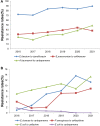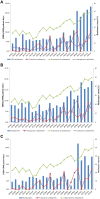Trends and Correlation Between Antimicrobial Resistance and Antibiotics Consumption in a Specialist Children's Hospital from 2016 to 2021
- PMID: 36193295
- PMCID: PMC9526424
- DOI: 10.2147/IDR.S381604
Trends and Correlation Between Antimicrobial Resistance and Antibiotics Consumption in a Specialist Children's Hospital from 2016 to 2021
Abstract
Purpose: To explore the trends and correlation between antibiotics consumption and antimicrobial resistance in children in a specialist hospital from 2016-2021 in China.
Patients and methods: This retrospective study investigated data on the consumption of antibiotics and antimicrobial resistance in children. Antibiotics consumption was expressed as defined daily doses (DDDs)/1000 patient-days based on the Guidelines for Anatomical Therapeutic Chemical. The trends in antibiotics consumption and antimicrobial resistance rates were analyzed by linear regression, while Spearman correlation analysis was employed to evaluate their correlations.
Results: An increasing trend in the annual consumption of carbapenems and monobactams was detected (all P<0.05). A significant upward trend was detected in the annual resistance rates of Enterococcus faecium to ciprofloxacin, Streptococcus pneumonia to ceftriaxone, Acinetobacter baumannii to carbapenems, Enterobacter cloacae to carbapenems, Pseudomonas aeruginosa to ceftazidime, and Escherichia coli to cefepime, while the annual resistance rates of Escherichia coli to carbapenems had a significant downward trend (all P<0.05). The consumption of cephalosporin/β-lactamase inhibitor (C/BLI) combinations and carbapenems had significant positive correlations with the resistance rates of Acinetobacter baumannii to carbapenems (r=0.763, P<0.001; r=0.806, P<0.001), Enterobacter cloacae to carbapenems (r=0.675, P<0.001; r=0.417, P=0.043), and Pseudomonas aeruginosa to ceftazidime (r=0.625, P=0.001; r=0.753, P<0.001), respectively. Also, increasing consumption of monobactams was related to the upward resistance rates of Acinetobacter baumannii to carbapenems (r=0.557, P=0.005) and Enterobacter cloacae to carbapenems (r=0.507, P= 0.011).
Conclusion: This study demonstrated significant positive associations between antibiotics consumption and specific antimicrobial resistance rates. The current findings pointed out some directions to pursue in controlling the prevalence of certain resistant bacterial strains in children.
Keywords: antibiotic consumption; antimicrobial resistance; children; correlation.
© 2022 Gong et al.
Conflict of interest statement
The authors declare there are no conflicts of interest regarding the publication of this paper.
Figures


Similar articles
-
Trends and correlation between antibacterial consumption and carbapenem resistance in gram-negative bacteria in a tertiary hospital in China from 2012 to 2019.BMC Infect Dis. 2021 May 17;21(1):444. doi: 10.1186/s12879-021-06140-5. BMC Infect Dis. 2021. PMID: 34001022 Free PMC article.
-
Relationships between antimicrobial use and antimicrobial resistance in Gram-negative bacteria causing nosocomial infections from 1991-2003 at a university hospital in Taiwan.Int J Antimicrob Agents. 2005 Dec;26(6):463-72. doi: 10.1016/j.ijantimicag.2005.08.016. Epub 2005 Nov 8. Int J Antimicrob Agents. 2005. PMID: 16280243 Free PMC article.
-
Association between the rate of fluoroquinolones-resistant gram-negative bacteria and antibiotic consumption from China based on 145 tertiary hospitals data in 2014.BMC Infect Dis. 2020 Apr 7;20(1):269. doi: 10.1186/s12879-020-04981-0. BMC Infect Dis. 2020. PMID: 32264851 Free PMC article.
-
Retrospective Analysis on Antimicrobial Resistance Trends and Prevalence of β-lactamases in Escherichia coli and ESKAPE Pathogens Isolated from Arabian Patients during 2000-2020.Microorganisms. 2020 Oct 21;8(10):1626. doi: 10.3390/microorganisms8101626. Microorganisms. 2020. PMID: 33096921 Free PMC article. Review.
-
Treatment options for K. pneumoniae, P. aeruginosa and A. baumannii co-resistant to carbapenems, aminoglycosides, polymyxins and tigecycline: an approach based on the mechanisms of resistance to carbapenems.Infection. 2020 Dec;48(6):835-851. doi: 10.1007/s15010-020-01520-6. Epub 2020 Sep 1. Infection. 2020. PMID: 32875545 Free PMC article. Review.
Cited by
-
Relationship between Antibiotic Consumption and Resistance: A Systematic Review.Can J Infect Dis Med Microbiol. 2024 Mar 5;2024:9958678. doi: 10.1155/2024/9958678. eCollection 2024. Can J Infect Dis Med Microbiol. 2024. PMID: 38476862 Free PMC article. Review.
-
Uropathogens and Their Antimicrobial Resistance Profile at a Pediatric Tertiary Care Hospital in Kathmandu, Nepal.Am J Trop Med Hyg. 2025 Apr 1;112(6):1245-1251. doi: 10.4269/ajtmh.24-0624. Print 2025 Jun 4. Am J Trop Med Hyg. 2025. PMID: 40168960
-
In Vitro Microevolution and Co-Selection Assessment of Amoxicillin and Cefotaxime Impact on Escherichia coli Resistance Development.Antibiotics (Basel). 2024 Mar 7;13(3):247. doi: 10.3390/antibiotics13030247. Antibiotics (Basel). 2024. PMID: 38534682 Free PMC article.
-
Correlation between Stenotrophomonas maltophilia incidence and systemic antibiotic use: A 10-year retrospective, observational study in Hungary.Eur J Microbiol Immunol (Bp). 2024 Mar 5;14(2):185-194. doi: 10.1556/1886.2024.00022. Print 2024 May 14. Eur J Microbiol Immunol (Bp). 2024. PMID: 38441614 Free PMC article.
-
[Antibiotic stewardship programs in the Spanish emergency services: PROA-URG Study].Rev Esp Quimioter. 2024 Apr;37(2):163-169. doi: 10.37201/req/138.2023. Epub 2024 Feb 19. Rev Esp Quimioter. 2024. PMID: 38372121 Free PMC article. Spanish.
References
-
- Fu P, Leiyan H, Wang C, et al. Antimicrobial resistance profile of clinical isolates in pediatric hospitals in China: report from the ISPED Surveillance Program in 2019. Chin J Evid Based Pediatr. 2021;16(01):43–49. doi:10.3969/j.issn.1673-5501.2021.01.002 - DOI
LinkOut - more resources
Full Text Sources

